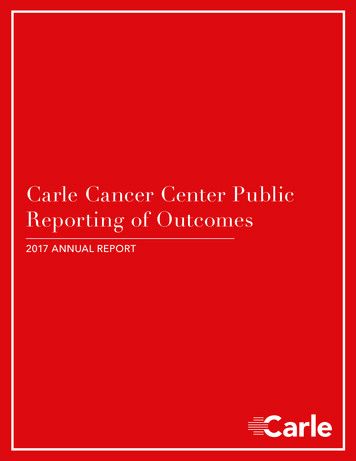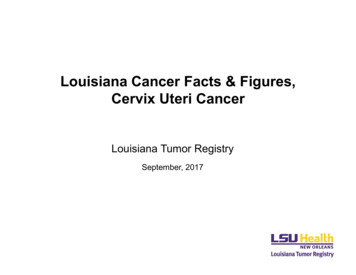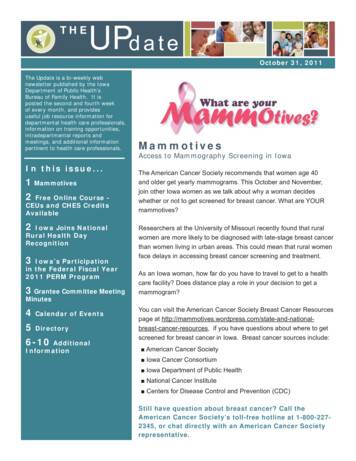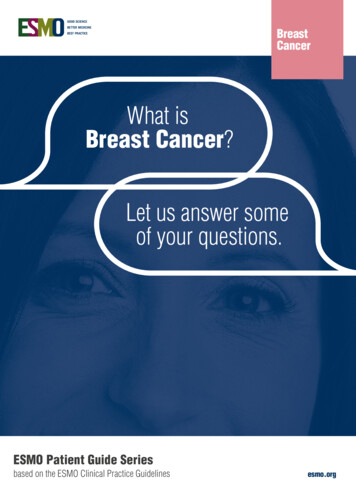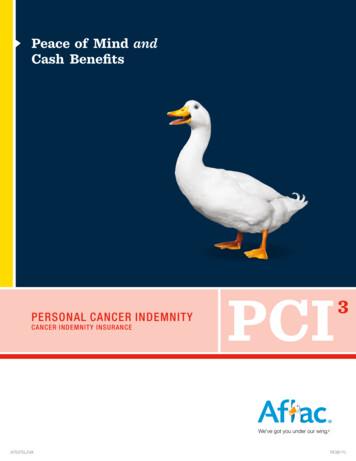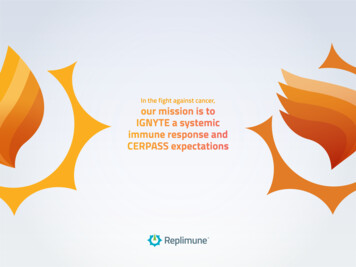
Transcription
In the fight against cancer,our mission is toIGNYTE a systemicimmune response andCERPASS expectations
MOA IGNYTE CERPASS OUTCOMES ADMINISTRATION REPLIMUNEOncolytic immunotherapy (OI) was designed to induce and bolster an1,2anticancer immune response while minimizing the effects on healthy tissuePrecision (local response): Oncolytic immunotherapies lyse tumor cells directlyat the site of injection, which causes the release of tumor-specific antigens1Amplification (systemic response): Tumor-specific antigens ignite a personalized, long-lasting,systemically mediated immune response to the patient’s cancer, including distant lesions1Local responseTumor-specific antigensTumor cellOncolytic immunotherapySystemic responseLytic viral replicationInfection of healthy cellsLimited viral replicationTumor cell lysisSystemic antitumor immune responseHealthy cellInfection of tumor cellsViral clearanceImmunotherapy is a foundational treatment in the fight against cancer,yet too many patients do not experience its full potential1
MOA IGNYTE CERPASS OUTCOMES ADMINISTRATION REPLIMUNEDiscover the science behind vusolimogene oderparepvec (RP1)2Vusolimogene oderparepvec (RP1)A potent clinical herpes simplex virus type 1 (HSV-1)strain was selected for lytic anticancer onsGALV-GP-RGM-CSFOutcomes Minimize replication in healthy tissue Replicate selectively in tumors Bolster direct tumor killing Induce a systemic anticancer immune responseReplimune is pioneering the development of potent, next-generation oncolyticimmunotherapies designed to enhance the anticancer immune response*Deletion of ICP47 also increases the expression of the US11 gene to further enhance vusolimogene oderparepvec replication in tumors.
MOA IGNYTE CERPASS OUTCOMES ADMINISTRATION REPLIMUNEIGNYTE provides evidence of an immune response in a range3,4of solid tumorsSingle-arm study of vusolimogene oderparepvec (RP1) in combination withOpdivo (nivolumab) in patients with locally advanced or metastatic solid tumorsInitial screening:Key primary end pointspatients with solidtumors (N 300) vusolimogene oderparepvec (RP1)intratumoral injection nivolumabFollow-upOverall response rate (ORR)Safety and tolerability4 weeks104 weeksUp to 100 daysKey secondary end pointsDuration of response (DOR)Tumor types:Key eligibility criteria:Complete response (CR) Skin cancers No prior oncolytic immunotherapyProgression-free survival (PFS)Overall survival (OS)SEE FULL ELIGIBILITY CRITERIANCT number: NCT03767348EudraCT number: 2016-004548-12– Anti-PD1–failed melanoma and nonmelanomaskin cancers– Nonmelanoma skin cancers (including CSCC, BCC,Merkel cell carcinoma) Other types of cancers– Anti-PD1–failed non-small cell lung cancer ECOG PS 0-1 At least one measurable tumor of 1 cm in longestdiameter or 1.5 cm in shortest diameter for lymphnodes, and injectable lesions, which in aggregatecomprise 1 cm in longest diameterClinical trial sites are available across the US, UK, and EU.– Anti-PD1–failed dMMR/MSI-H tumorsIGNYTE is now recruiting patients with skin cancers and select visceral tumorsContact Replimune to learn more about IGNYTE: clinicaltrials@replimune.com 1 (781) 222 9570Opdivo is a registered trademark of Bristol-Myers Squibb.BCC basal cell carcinoma; CSCC cutaneous squamous cell carcinoma; dMMR deficient mismatch repair; ECOG Eastern Cooperative Oncology Group; MSI-H microsatellite instability-high; PS Performance Status.
MOA IGNYTE CERPASS OUTCOMES ADMINISTRATION REPLIMUNEOur goal is to CERPASS what is expected from an immunotherapy4,5to treat cutaneous squamous cell carcinoma (CSCC)Study of vusolimogene oderparepvec (RP1) in combination with Libtayo (cemiplimab)vs cemiplimab alone to treat locally advanced or metastatic CSCC Initial screening:Key primary end pointsObjective response rate (ORR)patients withadvanced CSCC(N 180)vusolimogene oderparepvec (RP1)intratumoral injection cemiplimab (N 120)2:1randomizationFollow-upcemiplimab (N 60)Complete response (CR)Key secondary end points4 weeks108 weeksDuration of response (DOR)Progression-free survival (PFS)Key eligibility criteria:Overall survival (OS) No prior oncolytic immunotherapySafety No prior anti-PD1 therapyUp to 5 years fromstart of therapy ECOG PS 1*SEE FULL ELIGIBILITY CRITERIANCT number: NCT04050436EudraCT number: 2018-003964-30 At least one measurable lesion (lesions 1 cm in longest diameter or perpendicular diameters, or 1.5 cm in shortestdiameter if lesions are lymph nodes) There is no minimum tumor size for injection provided there are injectable tumors that are in aggregate 1 cm at baselineClinical trial sites are available across the US, Australia, Canada, and EU.CERPASS is now recruiting patients with locally advanced or metastatic CSCCContact Replimune to learn more about CERPASS: clinicaltrials@replimune.com 1 (781) 222 9570Libtayo is a registered trademark of Regeneron.*Patients with ECOG PS 2 at baseline may be allowed to enroll provided their PS 2 status is only related to the disease under study (eg, CSCC), they fulfill all other eligibility criteria, and consult with the medical monitor.
MOA IGNYTE CERPASS OUTCOMES ADMINISTRATION REPLIMUNEBased on preliminary data from IGNYTE,Complete responses have been observed in patients with CSCC4Duration of best response*% Tumor reduction10080Individual patientsChange from baseline (%)6040200-20-40-600100Initial RP1 treatment period200300400500600700800PD1-naiveDays on studyPD1-naivePD1-naive-80 anti-PD1 failed melanoma(cutaneous, mucosal, or uveal)-100anti-PD1 failed melanoma(cutaneous, mucosal, or uveal)Complete responseanti-PD1 failed melanomaComplete responsePartial response(cutaneous, mucosal, or uveal)PD1-naivePartial responseProgressive diseaseanti-PD1 failed melanoma(cutaneous, mucosal, or uveal)anti-PD1 failed melanomaComplete response ProgressivediseaseExcisional(cutaneous, mucosal, or uveal)Excisional DeathComplete responsePartial responsePD1-naiveData as of 6/3/2021.*Patients with a best response of at least stable disease (SD).Complete responseCompleteresponsePartial responsePartialresponsePartial responseProgressive diseaseExcisionalProgressive diseaseProgressivedisease DeathDeathTreatment ongoingOngoingresponseOngoing responseMucosal PD1-naiveProgressive disease ExcisionalDeathMucosal PD1-naiveMucosal PD1-failedExcisionalOngoing responseMucosal PD1-failedUVEAL PD1-naiveDeath
MOA IGNYTE CERPASS OUTCOMES ADMINISTRATION REPLIMUNEBased on preliminary data from IGNYTE,Compelling activity has been observed in patients with cutaneous melanoma,4including in patients who have progressed on prior immunotherapyDuration of best response*% Tumor reduction†10080Individual patientsChange from baseline 1 failedmelanoma-80(cutaneous, mucosal, or uveal)-100PD1-naive0100Initial RP1 treatment periodanti-PD1 failedmelanomaCompleteresponse(cutaneous, mucosal, or uveal)anti-PD1 failed melanomaPartial responsePD1-naiveResponses are durable with extended clinical benefit also seen in patients with a best response of SD(cutaneous, mucosal, or uveal) Reinitiation of RP1 shown to be feasible and associated with additional antitumor activityPD1-naiveCompleteresponseProgressive (cutaneous, mucosal, or uveal)Days on studyanti-PD1 failed melanomaComplete response Partial responseExcisional(cutaneous, mucosal, or uveal)Progressive diseaseDeathComplete responsePartial responseComplete responseCompleteresponsePartial responsePartialresponsePartial responseProgressive diseaseExcisionalProgressive diseaseExcisionalProgressivedisease ExcisionalData as of 6/3/2021.Progressive disease ExcisionalDeath*Patients with a best response of at least SD.†Complete response by positron emission tomography scan (no metabolic activity seen).ExcisionalOngoing response‡DeathSurgical CR.DeathTreatment ongoingOngoingresponseMucosal PD1-naiveOngoing responseMucosal PD1-failedMucosal PD1-naiveUVEAL PD1-naiveCutaneous anti-PD1 naiveCutaneous anti-PD1 failed
MOA IGNYTE CERPASS OUTCOMES ADMINISTRATION REPLIMUNEPreliminary data from IGNYTE4Treatment-emergent adverse events (TEAEs) in patientswith locally advanced and metastatic skin cancers (N 69)Selected efficacy data in patients with CSCC or melanomaCSCC (locallyadvanced andmetastatic)Number ofpatientsOverallresponse *60%47%13%7%Cutaneousmelanoma(anti-PD1 naive)863%38%25%25%Grade 1-2, % occurringin 10% of patientsGrade 3, .10Influenza-like ased 10.10Tumor pain10.10Cutaneousmelanoma(anti-PD1 failed)1631%6%25%13%†Data as of 6/3/2021.*One patient died before the first response assessment.†One SD patient has the potential for response following ongoing RP1 re-initiation. One patient withSD underwent complete surgical removal of the residual tumor at 4 months, ongoing at 18 months.
MOA IGNYTE CERPASS OUTCOMES ADMINISTRATION REPLIMUNEPatient with a complete response in locally injected4and distant, uninjected tumorsRecurrent CSCC of the neck (bilateral), previously treated with cisplatin-based chemoradiationand 6 carboplatin/5-FU; tumor reduction began prior to first dose of Opdivo Baseline8 weeks24 weeksBaseline8 weeks16 weeksRight neckBaselineLeft neckAfter RP1 injection, prior toimmunotherapy2 weeksRetroperitoneal lymph nodesAfter 2 doses of RP1 and 1dose of immunotherapy4 weeksLocally injected tumorsData as of 10/15/2020.Distant uninjected tumors
MOA IGNYTE CERPASS OUTCOMES ADMINISTRATION REPLIMUNEPatient with a complete response of CSCC foot and groin lesions4Baseline20 weeks (PR)38 weeks (CR)Baseline8 weeks24 weeksGroin nodes were initiallyinjected and a responsewas seen. Foot lesions weresubsequently injected.Locally injected tumorsData as of 6/3/2021.
MOA IGNYTE CERPASS OUTCOMES ADMINISTRATION REPLIMUNESystemic response in non-injected liver and lung tumors afterimage-guided injection to a liver tumor in a patient with cutaneous4melanoma after anti-PD1/anti-CTLA-4 failureBaseline20 weeks60 weeksBaselineLiver tumors60 weeksUninjected lung tumors reduced significantly in size following liver injectionLocally injected tumorsData as of 10/15/2020.20 weeksDistant uninjected tumors
MOA IGNYTE CERPASS OUTCOMES ADMINISTRATION REPLIMUNESystemic response after superficial injection in a patient with4cutaneous melanoma after anti-PD1/anti-CTLA4 failureBaseline2 weeks12 weeks56 weeksBaseline40 weeksLymph nodesLocally injected tumorsData as of 10/15/2020.BaselineLungDistant uninjected tumors40 weeks
MOA IGNYTE CERPASS OUTCOMES ADMINISTRATION REPLIMUNEVusolimogene oderparepvec (RP1) can be injected into cutaneous,subcutaneous, nodal, and visceral lesionsA typical in-office visit takes approximately 2 hours from patient check-in.The injection process takes 15 to 30 minutes for most cases.Administration to superficial lesions Vusolimogene oderparepvec (RP1) is administered as anintratumoral (IT) injection directly into superficial lesions(eg, visible lesions, subcutaneous lesions, and lymph nodes) Administration can be performed by trained nurses, nursepractitioners, and medical doctorsAdministration to deep visceral tumors guidedby imaging Vusolimogene oderparepvec (RP1) can be administered to tumorlesions by an interventional radiologist (IR) under guidance of anultrasound or CT scan Administration typically takes place in the IR department CT orultrasound roomWatch Jason Chesney MD, PhDof Brown Cancer Center describethe step-by-step process ofadministering RP1 to cutaneousand nodal lesionsWATCH NOWWatch Nicos Fotiadis MD, FRCR, EBIRof Royal Marsden NHS FoundationTrust walk through the step-by-stepprocess of administering oncolyticimmunotherapy to a tumor in the lungWATCH NOW
MOA IGNYTE CERPASS OUTCOMES ADMINISTRATION REPLIMUNEAbout ReplimuneReplimune is a clinical-stage biopharmaceutical company. Ourmission is to develop novel oncolytic immunotherapies based ona proprietary Immulytic platform to potently treat a broad rangeof cancers and enhance other immuno-oncology therapies withcomplementary mechanisms of action. We conduct our clinical trialswith the highest possible standards across global clinical trial sites.Visit our website for a comprehensive list ofoncolytic immunotherapy clinical trialsEXPLORE CLINICAL TRIALSVusolimogene oderparepvec (RP1) and its use in combination withcemiplimab or nivolumab are investigational therapies and are notapproved for use by the United States Food & Drug Administration (FDA),the European Medicines Agency (EMA) or any other regulatory authority.1. Davola ME. Mossman KL. Oncoimmunology. 2019;8(6):e1596006. doi.org/10.1080/2162402X.2019.1596006 2. Thomas S, Kuncheria L, Roulstone V, etal. J Immunother Cancer. 2019;7(1):214. doi:10.1186/s40425-019-0682-1 3. Study of RP1 monotherapy and RP1 in combination with nivolumab (IGNYTE).ClinicalTrials.gov identifier NCT03767348. Updated July 15, 2021. Accessed August 18, 2021. https://clinicaltrials.gov/ct2/show/NCT03767348 4. Data on file.Replimune Group Inc. Woburn, MA; 2021. 5. Study evaluating cemiplimab alone and combined with RP1 in treating advanced squamous skin cancer (CERPASS).ClinicalTrials.gov identifier NCT04050436. Updated June 28, 2021. Accessed August 18, 2021. https://clinicaltrials.gov/ct2/show/NCT04050436 2021 Replimune, Inc. 8/21 v1
IGNYTE provides evidence of an immune response in a range of solid tumors3,4 Up to 100 days Single-arm study of vusolimogene oderparepvec (RP1) in combination with Opdivo (nivolumab) in patients with locally advanced or metastatic solid tumors IGNYTE is now recruiting patients with skin cancers and select visceral tumors






